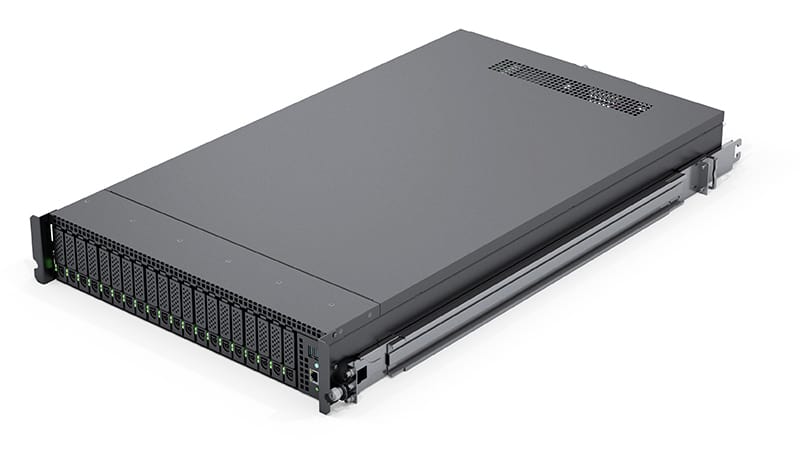
General Micro Systems (GMS) has launched its Velocity ‘4×4’ quad General-Purpose Graphics Processing Unit (GPGPU) Artificial Intelligence (AI) server designed for battlefield applications like command posts, tactical operation centers, and protected platforms such as autonomous vehicles, wide body airborne sensor fusion, surveillance, data mining, synthetic vision and any platform that needs massive computational resources from a small, air-cooled rackmount server.
Velocity ‘4×4’ delivers mission success with a data center’s worth of supercomputer AI algorithm processing in a single rackmount server equipped with industry-standard connectors.
The Velocity 2U ‘4×4’ quad NVIDIA A100 GPGPU AI server balances the four high-performance domains for maximum data processing: Central Processing Units (CPUs), GPGPUs, 100Gb Ethernet sensor Local Area Network (LAN) ports, and 22 Solid-State Drive (SSD) disk array.
Velocity 2U has the capability for quad NVIDIA GPGPU Ampere Core co-processors mated to quad Intel Scalable Xeon 28 core data center processors, each with 1TB of DDR4 ECC memory and 4TB total. The 112 CPU cores and four GPGPUs are connected via the server’s x16 PCIe Gen 3 fabric with 128Gbps of on-board bandwidth—more than enough to keep up with AI sensor processing and storage.
Velocity is designed from the ground up to balance the information flow through the server, with data moving:
- To/from the 16 Mellanox 100Gb Ethernet ports connected to real-time sensors or other sub-systems
- Through the four Intel CPUs and four A100 Ampere Core GPGPU co-processors
- To the Broadcom hardware RAID NVMe 22 SSD array
GPGPUs, 100Gb Ethernet ports, CPUs and SSDs are intelligently grouped and balanced to maximize throughput, reduce latency, and equally load the processors and ports. The optionally encrypted FIPS-140-2 SSDs are the fastest available x4 NVMe drives, streaming at 32 Gbps per drive. Data flows smoothly through the server, never stalling, which further increases overall performance.
The Velocity server is available off-the-shelf. The need for immediate, extreme edge computing and on-platform AI algorithm data processing is acute, as Army programs like Project Quarterback, ATLAS, NGCV and other Futures Command projects demand real-time decisions and multi-platform sensor sharing. Sending data for processing back to a command post, to the cloud, or to CONUS is too slow and the data links too congested.
“When we worked with the Army to provide the sensor local area network, server processor and intelligent displays for the Multi-Function Video Display (MVD) mine-clearing program on MRAPs, we saw first-hand the insatiable desire for more and more on-platform processing,” said Ben Sharfi, founder and chief architect, GMS.
“The ‘4×4’ Quad AI GPGPU server was born from what GMS learned working with the Army on MVD and follow-on programs. It was equally inspired by the airborne GMS TITAN CSSP and CSVP conduction-cooled 2U servers used in the Navy’s P-8 Poseidon aircraft. In fact, the ‘4×4’ Quad AI GPGPU server shares a similar commercial architecture with the Navy’s GMS servers, used to run the Minotaur software mission system forMaritime Patrol and Reconnaissance. Both Army and Navy systems require massive AI workloads in very small racks. Both programs rely on GMS servers.
“With only a tiny 2U slot available, we’re providing four of NVIDIA’s latest-available Ampere GPGPUs, four of Intel’s best data center CPUs, 16 100Gigabit Mellanox Ethernet ports and 264TB of NVMe storage controlled by Broadcom RAID.
“This is more than what anyone’s seen on the battlefield to-date—in only 2U. As an example, in real time, the ‘4×4’ Quad AI Velocity server can accept high resolution image data from 1600 1Gbit high-resolution sensors, and then process, analyze, and perform Fast Fourier Transforms for frequency domain calculation before converting the data back into the time domain, and storing 264TB of it. The capabilities of the Velocity 2U are vastly beyond what the military has seen previously on the battlefield.”
Key performance specifications for the Velocity 2U server include:
- 4x Intel Scalable Xeon data center 28-core CPUs (112 total cores)
- 4x x16 PCIe Gen 3 slots for 4x 250W NVIDIA dual-slot (or equivalent) GPGPU AI co-processors
- 4TB of balanced DDR4 ECC SDRAM
- 16x 100 Gb Ethernet LAN sensor ports
- 22 SSD array with up to 264TB storage, RAID-capable x4 PCIe Gen 3 NVMe drives
- 144 PCIe Gen 3 lanes via 8 slots for user I/O modules
- Operates 0 °C to +40 °C (optional -20 °C to +75 °C)
- 2U design only 30” deep
- Redundant, hot-swappable CRPS power supplies
GMS’ proven RuggedDNA cooling, packaging and ruggedization techniques are carried forward into Velocity ‘4×4’ servers from 40 years of military deployed VME, VPX and small form-factor systems. The servers exceed typical data center specs for extended temperature, high shock, and vibration, and are ideal for both fixed location and mobile (vehicle) applications. The servers can operate over a wider -20°C to +75 °C temperature range while offering the long‑life expectancy required for Department of Defense (DoD), government, or other high-availability and high-reliability applications.
The Velocity server is one of a family of 1U and 2U rugged servers. All Velocity and sister shortrack Vortex server variants have a 1GbE LAN port, console video, optional hardware or software RAID, a BMC with dedicated Ethernet port, TPM, and optional 10/40 GbE (copper or fiber). A DVD/Blu-ray drive is also optional, as are serial ports and audio I/O. Single or dual-redundant power supplies are standard, in 110 VAC or 220 VAC, plus select DC voltages. Optional features like zeroize via GMS SecureDNA or hardware secure erase via FIPS-140 or Opal 197 drives, allows for crypto data-at-rest on the removable SSD media.












